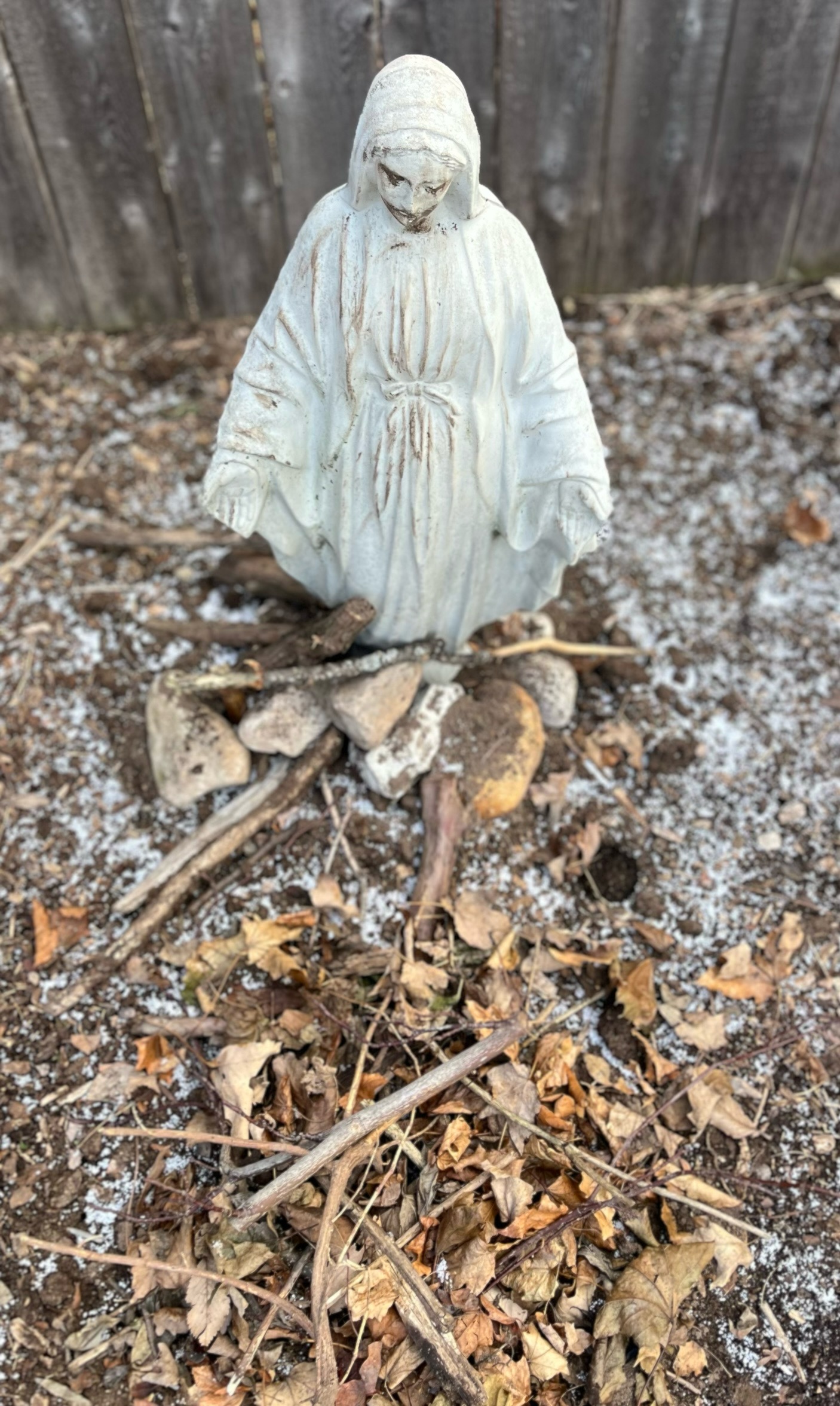Catholic Family
It was a terrible calamity, and the little people at our house were completely up in arms.
The concrete statue of Our Lady of Grace that sits between two bushes in our yard had been blown over by a strong winter wind. She lay diagonally against the neighbor’s fence, palms and face pointing heavenward, like a weary mother at bedtime prayers who can’t quite stand up straight.
The children were dismayed that Mary should suffer this indignity, and went to work reinforcing the statue’s base by employing a host of questionable engineering strategies. They piled sticks and rocks and mud around the little hemisphere upon which she stands, crushed serpent slithering beneath her feet. They set to work using mud to patch “cracks” they became convinced had developed in the concrete. It became quite a hearty little ministry, and their zeal for Mary’s comfort intensified with every subsequent project, as they all sought to ought-do each other.
Finally, my son announced he had to make her a campfire and get her a jacket and hat. “It’s cold out here, and she’s only wearing that dress,” he said.
Of course, then a quarrel ensued: one of the children wasn’t building a campfire correctly, another was overstepping his bounds, one was feeling sidelined, one refused to surrender her coat for the comfort of the Blessed Virgin. The whole exercise was a microcosm of the modern Church, really: a great, elaborate struggle to please God, each participant completely certain of the rightness of his own methods (at least, he is completely certain when contradicted by someone who disagrees).
I watched them with equal parts admiration and amusement. I am under no delusions that this playtime activity was an indication of any great piety on their part. These were normal gestures made by normal children to an object of their affection. But there was something so innocent and pure in their enthusiasm. There was something so lovely in their determined belief that they could, in fact, offer some kind of consolation to God by their actions.
How sweet it seemed. How naive. How silly.
As a family, our prayer lately has been for God to fill us with a genuine yearning for holiness. I always assumed that I wanted to be holy, that I was trying my best to be holy. But when I really thought about it, was holiness something I desired? Or was it a hill I watched other people climb, while I thought to myself: “How sweet. How naive. How silly.”
Striving for holiness is different from wanting to do the right thing, an action which offers lots of benefits that have nothing to do with our souls. “Being a good person,” that nebulous yardstick of morality popularized by secular culture, is not an unworthy goal. But it’s also not enough. You can be a “good person” in this world by doing just enough, by giving just enough. By being kind (most of the time). By making the right choice (most of the time). A good person is usually admired and well-liked, because they are deemed good for actions that are visible, public.
You can be “a good person” and still risk nothing, lose nothing, suffer nothing.
But a holy person? A holy person is usually a freak. Look at any of the great saints, and you’ll see that most of their peers looked at them a little askance. We admire them now, when death and canonization frame their earthly struggle as heroic. But while it was happening? When they were just ordinary, sinful, fallen people trying to be holy, trying to do whatever objectively crazy thing it was that God was asking them to do? When Bernadette smeared her face with mud and Rose donned a crown of spikes and Veronica offered a towel to a man that everyone hated?
Well, they may as well have been making campfires for a concrete statue.
That’s the struggle for holiness, really, in a nutshell: doing something that makes no sense, that gives no benefit that anyone can see or touch or smell. Doing it badly, haphazardly, but doing it with purpose. Doing it simply because you’re motivated by a feeling deep within you, some little fledgling stirring of love in the recesses of your soul.
We can only be holy by following that feeling, even when everyone else thinks we’ve totally lost it. “How childlike. How naive,” they say when we go to Mass, when we whisper our sins through a grate, when we politely ask someone who has been dead for centuries to pray for us. “How silly.”

Sometimes, holiness looks like building a campfire for a concrete statue. (Photo by Colleen Jurkiewicz)
